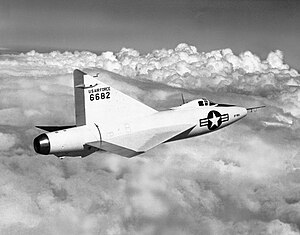This is an old revision of this page, as edited by Wolfkeeper (talk | contribs) at 22:14, 19 April 2006 (→Performance). The present address (URL) is a permanent link to this revision, which may differ significantly from the current revision.
Revision as of 22:14, 19 April 2006 by Wolfkeeper (talk | contribs) (→Performance)(diff) ← Previous revision | Latest revision (diff) | Newer revision → (diff)
The Convair XF-92 was the first American delta-wing aircraft. The design was originally developed by Dr Alexander Lippisch of Germany before and during World War II as the ramjet powered Lippisch P.13a, but progressed only to a powerless glider example. After moving to the US as part of Operation Paperclip, Lippisch managed to interest Convair in building the design with a jet engine as a point-defense interceptor. Like the P-13, the F-92 was eventually built only as a prototype, the XF-92.
The original Lippisch wartime design consisted of two large triangles joined together. One formed the main structure and wing, the other was the vertical stabilizer and cockpit. The only deviation from the triangular layout was an oval air intake at the nose, and nozzle at the rear. The engine was powered by coal dust stored in a large rotating disk.
As jet engines rapidly improved in performance, Lippisch redesigned the P-13 for jet power, but keeping the original mission. The Whittle-derived Allison J33 engine available for use at the time was rather "portly", and would not fit cleanly into the wing, forcing a redesign. The new layout placed the engine in a seemingly oversized cylindrical fuselage, with the pilot sitting in a separate cockpit centered in the middle of it, serving double duty as a shock cone for the engine intake. The rudder, no longer serving as the cockpit as well, was reduced in size. The basic layout was very similar to the Miles M.52 design, although the M.52 did not use a delta wing. For added thrust, the engine nozzle was surrounded by a series of small solid-fuel rockets. In this form the Model 7002 was presented to the US Air Force in 1946, and was accepted for development as the F-92.
In order to gain in-flight experience with the delta wing layout, Convair suggested building a smaller prototype, which became the XF-92A. This design was considerably more "conventional" than the interceptor, mounting the pilot in a conventional cockpit near the front of the aircraft. By the time the aircraft was ready for testing, the concept of the point-defense interceptor seemed outdated and the F-92 project was cancelled. Convair continued work on the XF-92A, however, intending to use it as a pure "x-series" aircraft. Its first flight was on September 18, 1948, at Edwards Air Force Base in California.

The XF-92A aircraft was powered by an Allison J-33-A turbojet engine with an afterburner, and was unique in having America's first delta wing. The delta wing's large area of 425 square feet (39 m²), thin airfoil cross section, low weight, and structural strength made this a great combination for a supersonic airplane (although the fuselage was of a pre-area rule design).
NACA's High-Speed Flight Research Station assumed flight testing in 1953. NACA pilot A. Scott Crossfield flew all 25 flights over the six month test period. The XF-92A had a bad pitch-up problem which was solved eventually by adding different wing-fence combinations.
Research from the XF-92A test program was used in the development of Convair's two later delta-winged interceptors, the F-102 Delta Dagger and the F-106 Delta Dart, as well as Convair's B-58 Hustler bomber.
Specifications (XF-92A)
General characteristics
- Crew: one pilot
- Length: 42 ft 6 in (12.99 m)
- Wingspan: 31 ft 4 in (9.55 m)
- Height: 17 ft 9 in (5.37 m)
- Wing area: 425 ft² (39.5 m²)
- Empty: 9,078 lb (4,118 kg)
- Loaded: 14,608 lb (6,626 kg)
- Maximum takeoff: lb ( kg)
- Powerplant: 1 x Allison J33-A-29 turbojet, 7,500 lbf (33.4 kN) thrust
Performance
- Maximum speed: 718 mph (1,156 km/h)
- Range: mi ( km)
- Service ceiling: 50,750 ft (15,450 m)
- Rate of climb: 8,135 ft/min (2,480 m/min)
- Wing loading: 34 lb/ft² (168 kg/m²)
- Thrust-to-weight: 0.51
Armament
Never installed
External links
Related content
Related development:
Comparable aircraft:
Designation sequence: F-89 - XF-90 - XF-91 - XF-92 - YF-93 - F-94 - YF-95
| Aviation lists | |
|---|---|
| General | |
| Military | |
| Accidents / incidents | |
| Records | |